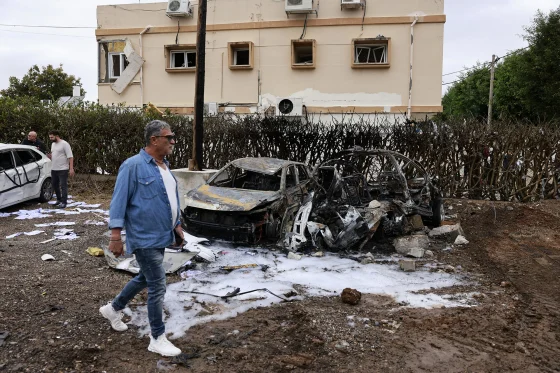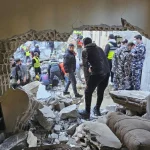Israeli Prime Minister Benjamin Netanyahu on Tuesday disclosed that he has recommended the approval of the ceasefire by his cabinet. The ceasefire is set to be agreed upon with Hezbollah which will end the hostilities in Lebanon. He further noted that in the case of a violation of the ceasefire, the country would respond in a powerful manner
While speaking in a televised address it noted that the ceasefire will allow the two nations to focus on the Iranian threat, He also noted that they will complete the elimination of Hamas, the return of all the hostages and the return of the residents of the north. The exact terms of the ceasefire were not disclosed by the authorities.
Earlier, a high-ranking intelligence official in Israel who was briefed on the ceasefire terms disclosed that Israeli forces would withdraw from Lebanon over 60 days under the deal.
It was further noted that Hezbollah, Iran’s most important proxy, would also withdraw to the north of Lebanon’s Litani River and about 5,000 Lebanese army troops would move to the south. The Lebanese military is not officially a party to the conflict.
Lisa Johnson, the U.S. ambassador to the U.N., had made the proposal available last week to Lebanon’s Parliament speaker, Nabih Berri, according to an adviser to the speaker, Ali Hamdan.
Recall that Hezbollah began trading fire with Israel on October 8th 2024 which was the day after Hamas had launched a terrorist attack on Israel from Gaza. Hezbollah says it is supporting the Palestinian resistance; Israel sees it as another attempt by Tehran to attack the Jewish state.
In the middle of the escalation of diplomatic activity, Israel fired missiles into Lebanon on Monday, killing at least 31 people in Beirut and the port city of Tyre. Meanwhile, It was further noted that Hezbollah sent more than 200 rockets at Israel on Sunday, leaving neighbourhoods in flames, according to the Israeli military.
Israeli ambassador to the U.N. Danny Danon on Monday stated that the strategically important Litani River is a key part of any deal from Israel’s perspective
It was further noted the stipulation that Hezbollah retreat north of the strategic waterway was also part of the deal that ended the 2006 war between Israel and Lebanon. But Hezbollah remained entrenched in the region. Israel sees its continued presence there as a grave threat.
Danon while speaking to a reporter at UN in New York stated that they were moving forward on the front of agreeing on a deal. Danin further stated that the goal was clear at the beginning which was to push Hezbollah north of the Litany River. It was confirmed that the deal had not been finalised but was moving forward.
He noted that it was important for Hezbollah not to be allowed to come back to the fence, and they will do whatever is necessary to guarantee it.
Israeli government spokesman David Mencer told Reuters that the agreement would also allow Israelis to act in self-defence to remove Hezbollah’s threat and enable the safe return of the residents of the north of Israel.
Three senior Biden administration officials on, Monday confirmed that a deal to end the conflict between Israel and Lebanon’s Hezbollah militia was close but not complete.
According to officials in the country., Israel has said it will not stop its attacks until the 60,000 residents of northern Israel who have been driven from their homes can return safely. It was noted that around 90 Israeli soldiers and 50 Israeli civilians have been killed since the conflict began a year ago. Figures have indicated that more than 3,500 people have been killed in Lebanon by Israeli bombing since the fighting started, according to Lebanon’s health ministry, a campaign that has displaced some 1.2 million people and unleashed a humanitarian crisis.
In this multifront war in the Middle East, the Lebanon conflict has become a key focus for Israel in recent months. That’s partly down to Hezbollah’s mighty missile arsenal, bigger than any other non-state group in the world and thought to be capable of overwhelming Israel’s missile defense.
The escalation of the conflict was traced to the action which was committed by Hamas’ terror attack which led to the death of 1,200 people and the kidnap of 250 others. After the attack, Hezbollah started firing missiles at Israel, which responded by launching rockets of its own. This then flared into a full-scale war in September, with Israel killing Hezbollah leader Hassan Nasrallah and significantly weakening the group.
War is still chewing on in Gaza, where a humanitarian disaster is playing out and more than 44,000 people have been killed, according to local officials.
The ceasefire would be limited to Lebanon, which shows that it would not bring consolation to Palestinians in Gaza or the dozens of hostages held by Hamas in Gaza.
The families of the hostages communicated and said they strongly urge any agreement to include a demand for the release of those who are being held.
The statement from the families shows that the October 7 attack, orchestrated by Hamas and supported by Iran, saw Hezbollah join the conflict, linking its fate to the war in Gaza and the atrocities of the October 7 massacre.
The statement further stated that the current efforts to secure an agreement ending the war on the northern front present a vital opportunity to bring all hostages home. According to them the northern front and the hostages’ release are inseparably linked as they cannot and must not treat them as separate issues.




